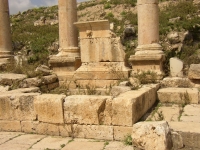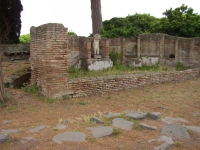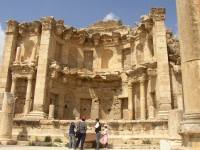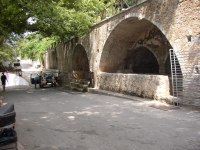



Fountains
The most important destination of aqueduct water was public fountains. For many people in Roman towns and cities these represented their main source of drinking water.Many fountains were of the simple and functional type: a stone basin with a spout, sometimes furnished with a decorative plaque or head. Rome, Pompeii and other ancient towns must have been equipped with hundreds of the 'lacus' (street fountains). On every location in Pompeii there was one within a circle of 50 meters.
The suplus water was drained away via an overflow into a gutter or reused in public toilets, see illustration.
More elaborate fountains were embellished with statues of deities, the imperial family, or local dignitaries who paid or helped to pay for the aqueduct. These ornamental structures were called 'munera' or nymphaea, like the ones in Gerasa (Jordan) and Olympia (Greece).
The remains of the Nymphaeum Alexandri - popular called the Trophies of Marius but this is a misnomer - can be found at the Piazza Vittorio Emanuele II in Rome. This special type of magnificent fountain that also functioned as a distribution station, was called a 'monstre' or monstra, and was probably fed by the Aqua Anio Novus. Part of the supply channel can still be seen at the junction of the Via Turati and the Via Pepe. The image of this particular nymphaeum was depicted on some Roman coins, see Roman aqueducts on coins nr. 5, to be compared to nr 11.
Even today some smaller towns and villages are still equipped with public waterworks, often a combination of a fountain for drinking water and a public washing place like in Krassi (Crete, Greece), Draguignan, and Maussanne-les-Alpilles (France).